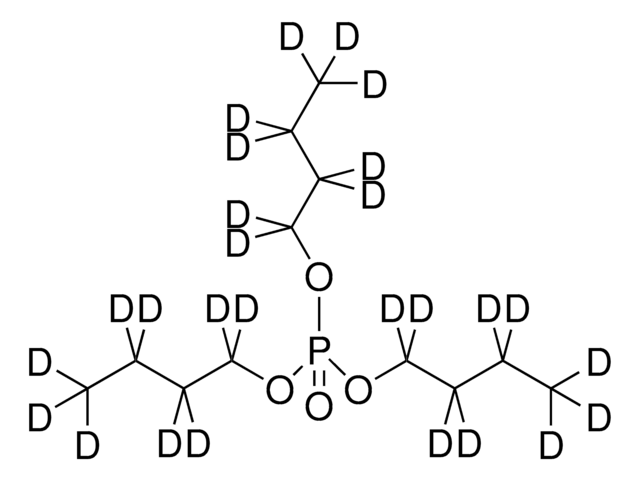32951
TDCPP
PESTANAL®, analytical standard
Synonym(s):
Tris(1,3-dichloro-2-propyl) phosphate, 1,3-Dichloro-2-propanol phosphate, Phosphoric acid tris(1,3-dichloro-2-propyl ester)
About This Item
Recommended Products
grade
analytical standard
Quality Level
product line
PESTANAL®
shelf life
limited shelf life, expiry date on the label
technique(s)
HPLC: suitable
gas chromatography (GC): suitable
density
1.514 g/mL at 20 °C (lit.)
application(s)
agriculture
environmental
format
neat
SMILES string
ClCC(CCl)OP(=O)(OC(CCl)CCl)OC(CCl)CCl
InChI
1S/C9H15Cl6O4P/c10-1-7(2-11)17-20(16,18-8(3-12)4-13)19-9(5-14)6-15/h7-9H,1-6H2
InChI key
ASLWPAWFJZFCKF-UHFFFAOYSA-N
Looking for similar products? Visit Product Comparison Guide
General description
Application
- Eggs by liquid chromatography-tandem quadrupole mass spectrometry (LC-MS/MS).
- Fish samples by gas chromatography-nitrogen-phosphorus detector (GC-NPD), LC-MS/MS and on-line turbulent flow chromatography (TFC) in conjunction with LC-MS/MS.
- Environmental samples by GC-MS/MS.
- Fruits and vegetables by GC-MS/MS and GC coupled with electron capture detection.
Recommended products
Legal Information
Not finding the right product?
Try our Product Selector Tool.
Signal Word
Warning
Hazard Statements
Precautionary Statements
Hazard Classifications
Aquatic Chronic 1 - Carc. 2
Storage Class Code
10 - Combustible liquids
WGK
WGK 2
Flash Point(F)
482.0 - 485.6 °F - open cup
Flash Point(C)
250 - 252 °C - open cup
Personal Protective Equipment
Choose from one of the most recent versions:
Already Own This Product?
Find documentation for the products that you have recently purchased in the Document Library.
Customers Also Viewed
Our team of scientists has experience in all areas of research including Life Science, Material Science, Chemical Synthesis, Chromatography, Analytical and many others.
Contact Technical Service


